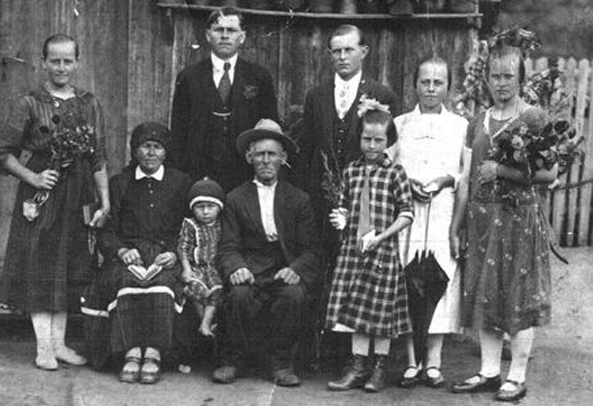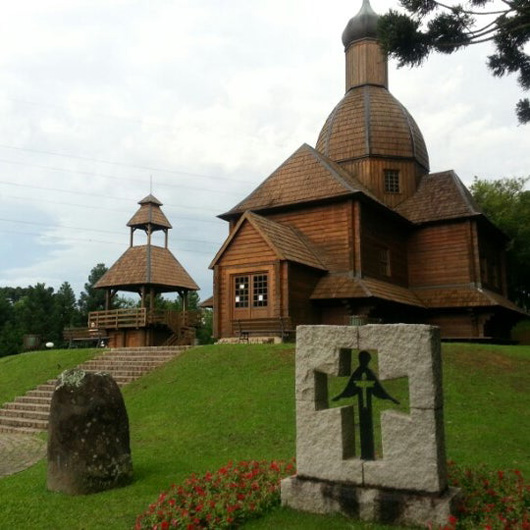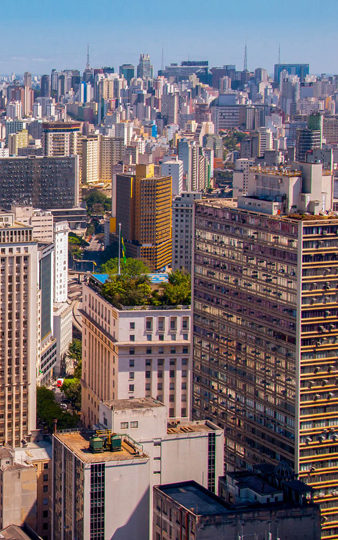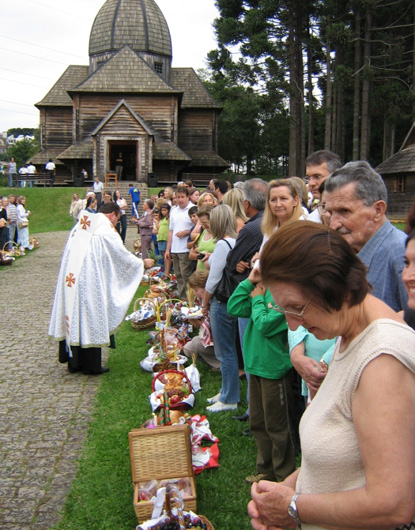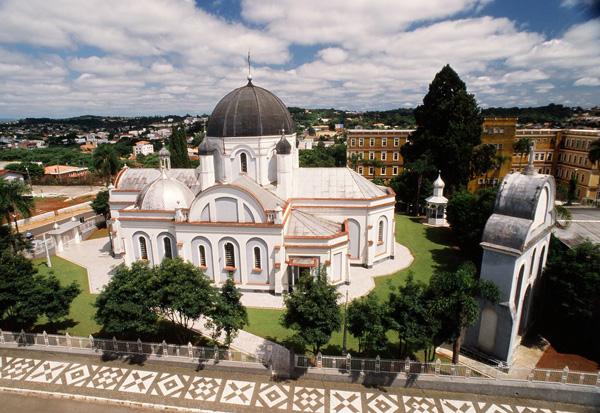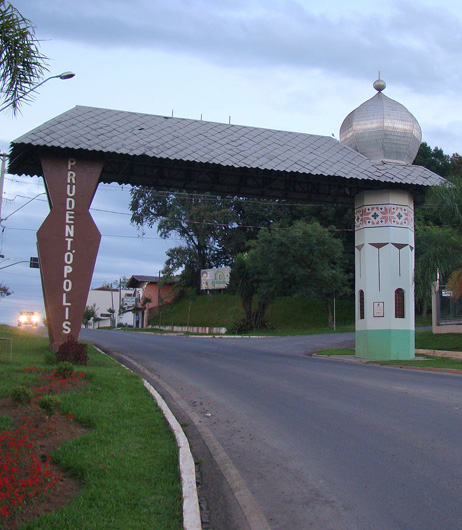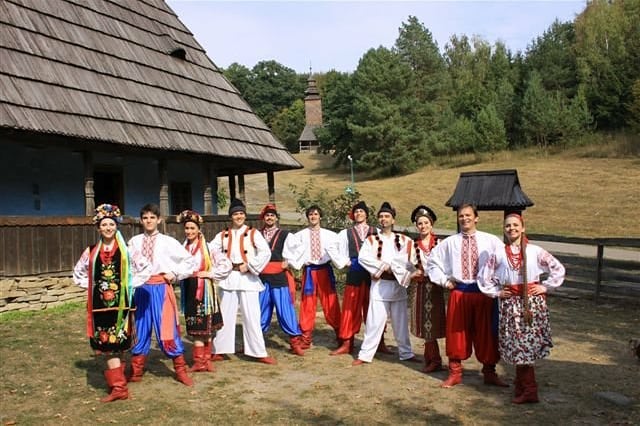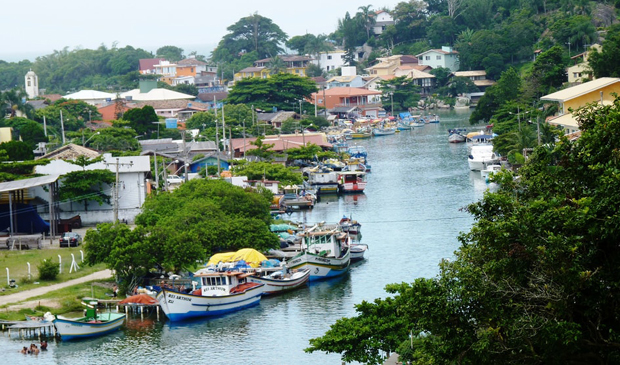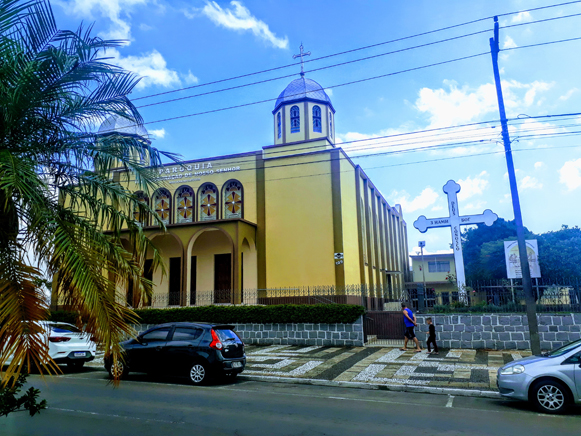Brazil
Brazil. Brazil, the largest country in South America, is a federation of 23 autonomous states, 4 territories, and the federal capital district of Brasília. The country has an area of 8,512,000 sq km and an estimated population in 2019 of 210,147,125.
History of Ukrainian settlement. Ukrainians began to settle in Brazil at the beginning of the 1870s. They came from Galicia and Bukovyna and settled in the state of Paraná. The first known immigrants were the family of M. Morozovych, from the Zolochiv region, who arrived in 1872. Mass immigration took place in three phases. The first wave of immigration from Ukraine, called ‘the Brazilian fever,’ occurred in 1895–7 and brought over 20,000 small farmers and landless peasants, who were promised cheap land by agents of Italian shipping companies. Instead of the promised black soil, the Ukrainian colonists received lots of uncleared forest in Paraná in the vicinity of Prudentópolis and Mallet. Some of them returned to Galicia. After this, fresh Ukrainian immigrants arrived in smaller groups of 700–1,000 people per year. A larger influx, of 15,000–25,000, took place in 1907–14, this time in response to the Brazilian government’s call for construction workers to lay the railroad from São Paulo through Paraná to Rio Grande do Sul. The second wave of immigration consisted of newcomers from Galicia and Volhynia between the world wars. The third wave took place in 1947–51, when about 7,000 Ukrainians arrived from displaced persons camps in Germany and Austria. These immigrants were socially more diverse and settled almost exclusively in the cities. Among them were many intellectuals, most of whom later emigrated to Canada or the United States.
Population. Although government statistics are inaccurate because Ukrainian immigrants were classified as Austrians or Poles and children born in Brazil were counted as Brazilians, the Ukrainian ethnic group in Brazil numbers 190,000–200,000, and 92.5 percent of its members are Brazilian-born. Of all of these Ukrainians, 78 percent live in the state of Paraná, 5 percent in the state of São Paulo (most of them in the city of São Caetano do Sul), 9 percent in the state of Santa Catarina, 6 percent in the state of Rio Grande do Sul, 0.8 percent in the state of Mato Grosso do Sul, 0.6 percent in the territory of Rondônia, 0.4 percent in the state of Goiás, and 0.2 percent in the state of Minas Gerais. The bulk of the Ukrainian ethnic population lives in Paraná in an area of 6,000 sq km that is known as ‘Brazilian Ukraine.’ Its largest concentration, 30,500, is found in southeastern Paraná in the county of Prudentópolis. There Ukrainians constitute 75 percent of the population. The city of Prudentópolis is a center of Ukrainian life, particularly religious life. The second-largest concentration is found in the city of Curitiba and its environs, where about 13,750 ethnic Ukrainians live and make up 1.3 percent of the population. Pockets of Ukrainians exist in other cities and towns of Paraná, such as Apucarana, Ivaí, Irati, Ponta Grossa, and União da Vitória, and in such counties of Santa Catarina as Itaiópolis, Papanduva, and Taió.
Religious life. Eighty-five percent of Ukrainians in Brazil are Catholic. The first Ukrainian Catholic chapel was built in Silva near Itaiópolis. In 1897 Ukrainian monks of the Basilian monastic order began to arrive in Brazil, followed by the Sisters Servants of Mary Immaculate in 1911. At first Ukrainian Catholics were subject to the Brazilian Roman Catholic hierarchy. Since the Brazilian church did not accept married priests, most of the Ukrainian priests were and still are members of the Basilian order. Under the dictatorship of G. Vargas in 1930–45, priests were forbidden to preach in Ukrainian. Ukrainian Catholics received their own vicar general only in 1952—Mgr C. Preima—and were brought under a new ordinary for Eastern-rite Catholics in Brazil—Archbishop J. Câmara. In 1958 they got their own bishop—Yosyp Martynets, who served as auxiliary bishop to Cardinal Câmara. Finally, in 1962, a separate exarchate was established under the direction of Bishop Martynets, whose residence was in Curitiba. At the same time Rev P. Busko was appointed vicar-general in place of Mgr Preima, who emigrated to the United States. In 1971 the Holy See created the Eparchy of Saint John the Baptist for all Brazil. Its seat is Curitiba. Bishop Martynets was appointed its first head, and Bishop Yefrem Kryvy, who was born in Brazil, was appointed auxiliary bishop with the right of succession. When Bishop Martynets resigned in 1978, Bishop Kryvy succeeded him.
The Ukrainian Eparchy of Saint John the Baptist encompasses 17 parishes, which are in the care of 52 priests, 43 of whom are Basilians and 9 diocesan. There are 179 churches and chapels, the most impressive of which are Saint Josaphat’s Church in Prudentópolis, the Cathedral of Saint John the Baptist in Curitiba, and the Church of the Nativity of the Virgin Mary in Curitiba. The following monastic orders are active in the eparchy: the Basilian monastic order, the Sisters Servants of Mary Immaculate, the Sisters Catechists of Saint Anne, the Sisters of Saint Joseph, the Basilian order of nuns, and the Sisters Catechists of the Sacred Heart of Jesus. The Basilian fathers run Saint Joseph’s Seminary in Prudentópolis and the Cardinal Tisserant Seminary in Marechal Mallet. Their monasteries in Ivaí and Curitiba support a novitiate and teach philosophy and theology. Most of the Ukrainian priests are now Brazilian-born, and many of them are graduates of Gregorianum University in Rome.
The Ukrainian Autocephalous Orthodox church consists of the descendants of colonists from Bukovyna and Volhynia, as well as Galician converts to Orthodoxy in the 1920s. The first parish was formed in 1926 in Jangada, Santa Catarina, by Galician settlers. Another parish was established in the following year in the colony of São Miguel, in Joaquim Távora, Paraná. These parishes were in the care of Rev M. Zombra, who came from Galicia. In 1929 the Orthodox community in Iracema, Santa Catarina, petitioned Archbishop Ioan Teodorovych in the United States to take the community under his care and to send a missionary to Iracema. This led to the formation of the first organized parish of the Ukrainian Autocephalous Orthodox church in Brazil in 1930. In 1931 Protopresbyter Dmytro Tiahnyhore, who was appointed head of the Ukrainian Orthodox mission in Brazil by Archbishop Teodorovych, arrived in Gonçalves Júnior. By 1938, 20 parishes and missionary outposts were established in Paraná and Santa Catarina. The period of dictatorship and nationalization in Brazil (1938–45) had a detrimental effect on the Orthodox church, and it lost most of its clergy. In 1942 the archimandrite, V. Postolian, left for Uruguay, where he was ordained by Archbishop M. Solovii. In 1945–8 Rev Postolian was the only Orthodox priest left in Brazil.
After the Second World War four Orthodox priests came to Brazil. In 1951 Protopresbyter F. Kulchynsky came from Canada to assume the duties of administrator of the church in Brazil. This led to important changes in the life of the church and to new organizational forms. In 1969 Bishop Yov Skakalsky became head of the Orthodox church for all of South America. When he died in 1974, the United States Council of Bishops appointed Bishop V. Hai as his successor. On Hai’s death in 1977 Metropolitan Mstyslav Skrypnyk appointed Rev M. Mylus as his representative and administrator of the Ukrainian Autocephalous Orthodox church in South America. The church has about 8,000 members in Brazil, who constitute 4 percent of the Ukrainian population. They are organized in 14 parishes and missionary posts and are served by five priests. The largest churches are Saint Volodymyr’s Church in São Caetano do Sul, built in the Ukrainian style; Saint Michael’s Church in Curitiba; and Saints Peter and Paul’s Church in Gonçalves Júnior.
Ukrainian Evangelical Baptists first came to Brazil after the Second World War and settled mostly in the state of São Paulo. In 1951 the first Baptist congregation was formed in São Caetano do Sul under the leadership of Pastor S. Molezhnyk. In 1955 it adopted the official name First Ukrainian Baptist church. From 1960 its pastor was D. Butsky. There are about 300 Ukrainian Baptists in Brazil.
Social and political life. At first Ukrainian settlers congregated around their churches and parish organizations. The first secular organizations appeared in the early 1900s. In 1902 a Prosvita society was founded in Curitiba. On the eve of the First World War there were 32 Ukrainian organizations in Brazil. They spanned the entire political spectrum, from conservative to radical. The largest of them was Ukraine (Ukraina) in Prudentópolis, which was supported by the Basilian monastic order. The second largest was the Ukrainian Union, which was founded in Porto União in 1922. In 1934 its central office moved to Curitiba. In 1938 its name was changed to the Union for Agricultural Education (União Agrícola Instrutiva), and it became the cultural center of Ukrainian life in Brazil. In 1940 the corporatist government of G. Vargas dissolved all immigrant organizations in Brazil. With the return to a democratic order the union resumed its activities in 1947 and was ideologically associated with the OUN (Melnyk faction). In the same year the Society of Friends of Ukrainian Culture was founded in Curitiba; it was ideologically close to the hetmanite movement and the OUN (Bandera faction). In 1949 the Sociedade Ucraniana Unificação was established in São Caetano do Sul; its activities were limited to the state of São Paulo. In 1971 the Brazilian Center for Ukrainian Studies was established in Curitiba. In the last few years the activities of the Union for Agricultural Education have expanded greatly. Publishing has been resumed, and weekly radio broadcasts were begun, first in Ukrainian and later, in response to government demands, in Portuguese.
The Union for Agricultural Education (see Organization of Ukrainian Women in Brazil) and Sociedade Ucraniana Unificação each have a women’s section. In 1967 a conference of all women’s organizations in South America that are members of the World Federation of Ukrainian Women's Organizations was held in Curitiba. There also exist youth organizations, which are affiliated with parishes and various societies. The largest youth group today is the Literary and Sports Youth Center of the Union for Agricultural Education in Curitiba. In 1980 the Catholic eparchy founded the Religious and Cultural Center for Ukrainian Youth in Curitiba.
Attempts to set up a federation of Ukrainian organizations—including the Ukrainian People’s Council in Prudentópolis, formed by the first congress of Ukrainians in Brazil in 1910; the Ukrainian People’s Council, created at the congress in Dorizón in 1919; and the Ukrainian Union, founded at the congress in Dorizón in 1922—were short-lived. Even the Ukrainian-Brazilian Committee, which was formed by three Ukrainian organizations in Curitiba in 1953, disintegrated in 1956 because of political conflicts. In spite of their disunity, the Ukrainians in Brazil always took a keen interest in events in Ukraine and responded to them actively. In 1920–2 Petro Karmansky, a representative of the Western Ukrainian National Republic, collected a large sum in Brazil in aid of the republic. Later the Ukrainians in Brazil supported various Ukrainian causes. Only in 1985 the Ukrainian Brazilian Central Representation, an umbrella organization for Ukrainians in Brazil, was established in Curitiba.
Ukrainians have been active in Brazilian politics in two ways: they have informed the government and the mass media about Ukraine, and they have participated in the party politics of Brazil. Since 1946 Brazilians of Ukrainian origin have been elected to state legislatures and the federal parliament. In Paraná many Ukrainians hold government posts, and even more of them are elected to local and municipal councils.
Education and cultural life. Ukrainian private schools were first organized by the better-educated immigrants in 1897–8. In 1913, as a result of the efforts of the Basilian monastic order, the School Union was established. In 1938, when the Vargas government prohibited immigrant schools, there were 41 Ukrainian schools in Prudentópolis county alone. By 1938 the Sisters Servants of Mary Immaculate ran 18 schools, some of which were boarding schools. Today their schools are government supervised and subsidized. In 1926–7 the Ukrainian Union founded a junior gymnasium in Porto União, but efforts to establish a full gymnasium did not succeed. Only in 1935 was a permanent Ukrainian secondary school, with two languages of instruction—Ukrainian and Portuguese—established: Saint Joseph’s Minor Seminary, directed by the Basilian fathers in Prudentópolis. The Ukrainian language is taught as an extracurricular subject in the 32 elementary and 3 secondary schools of the Sisters Servants, at the Saint Olha Institute in Prudentópolis (which was founded in 1941 and is run by the Sisters Catechists of the Sacred Heart of Jesus), and at evening, weekend, and summer schools run by various parishes and organizations.
The Ukrainian press in Brazil began to appear at the beginning of the 20th century. In 1907–9 S. Petrytsky published a radical biweekly, Zoria (Curitiba). The Catholic bimonthly Prapor (Brazil) was published first in Curitiba and then in Prudentópolis in 1910–11. The Basilian fathers have published the monthly Ukraïns’kyi misionar in Prudentópolis since 1911. The Catholic weekly Pratsia (Brazil) has been published with a few interruptions since 1912. In 1924 Petro Karmansky founded the weekly Ukraïns’kyi khliborob in Porto União. From 1938 it was published in Curitiba under the name Khliborob (Curitiba) by the Union for Agricultural Education. In 1974 it changed its name to Informatyvnyi biuleten’ and now appears irregularly. Many periodicals appeared only briefly: the semimonthly Ukraïna, published in Curitiba in 1919; the monthly Samoosvitnyk, published in Prudentópolis in 1935–40; Nash napriam, published in Curitiba in 1937–8; Nasha dumka, published in São Paulo in 1948; Sobornist’, published in São Paulo in 1966–8; and Pravoslavna nyva, published by the Ukrainian Autocephalous Orthodox church in Brazil in 1954–70. The Basilian fathers’ publishing house in Prudentópolis has published religious, educational, and popular literature since 1912.
In the early days of Ukrainian settlement in Brazil an important role in Ukrainian cultural life was played by Valentyn Kuts, S. Petrytsky, Petro Karmansky, Yosyp Martynets, the priests P. Protskiv, S. Kizyma, M. Shkirpan, K. Bzhukhovsky, and O. Ananevych. Several early immigrants wrote on Brazilian themes: V. Kuts, P. Karmansky, S. Kalynets, and Osyp Shpytko. The more recent generation of writers consists of Vira Vovk, Helena Kolody, O. Zaporizky, Oleksa Senyk, and Olha Mak, who emigrated to Canada in 1971.
The most prominent Ukrainian artists and musicians in Brazil are the landscape painter M. Bakun, the portrait painter Dmytro Izmailovych, the sculptor O. Narozhniak, and the pianist L. Borushenko.
Ukrainian scholars are usually employed by Brazilian universities: in 1980, 52 Ukrainians held university appointments.
Ukrainian folk arts are cultivated by Ukrainians in Brazil. Amateur groups devoted to painting Easter eggs, embroidery, woodcarving, folk singing, and dancing display their skills at folk festivals. The largest amateur group, over 100 people, is connected with the Union for Agricultural Education.
Economic life. Almost 75 percent of Ukrainians in Brazil (compared to 52 percent of Brazilians in general) are occupied in farming. They grow wheat, rye, buckwheat, potato, and local crops such as rice and sweet potato. Industrial crops such as mint, sunflower, castor bush, maté, and coffee are widely raised. The Ukrainian settlers have made beekeeping popular in Brazil and have developed new species of fruit trees by grafting and cross-breeding. Ukrainian farmers also raise cattle, poultry, and hogs for their own use and for sale at local markets. Generally the Ukrainian farmers in Brazil are poor. Today successful agriculture requires a large investment of capital or a co-operative system. Unfortunately, in spite of the efforts of Valentyn Kuts and other leaders, there are no Ukrainian co-operatives in Brazil.
Some Ukrainians work in industry or in small manufacturing firms. Relatively few Ukrainians—only about 8 percent—work in professions such as medicine, dentistry, pharmacy, law, engineering, agronomy, or in government jobs at the federal, state, or municipal level.
BIBLIOGRAPHY
Karmans'kyi, P. Mizh ridnymy v Pivdennii Amerytsi (Vienna 1922)
Gluchowski, K. Materiały do problemy osadnictwa polskiego w Brazyliji (Warsaw 1927)
Zin'ko, V. Ridna Shkola v Brazyliï (Prudentópolis 1960)
Boruszenko, O. ‘A Imigração Ucraniana no Paraná,’ in Anais do VI Simpósio de História (Porto Alegre 1969)
Strelko, A. ‘Primeros immigrantes ucranianos en Latino America,’ America Latina, no. 1 (Moscow 1975)
Borushenko, O. ‘Ukraïntsi v Brazyliï,’ in Ukraïns'ki poselennia: Dovidnyk, ed A. Milianych et al (New York 1980)
Oksana Borushenko
[This article originally appeared in the Encyclopedia of Ukraine, vol. 1 (1984).]
